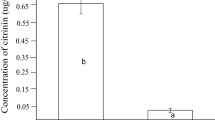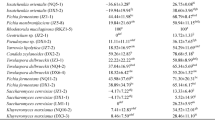Abstract
In this study, the in vitro effects of chlorine dioxide (ClO2) in growth reduction against Candia glaebosa, Zygosaccharomyces bisporus, Saccharomycopsis capsularis and Pichia pastoris involving in deterioration of fermented hot pepper paste were studied to assess the applicability of chlorine dioxide to preparation of fermented hot pepper paste, and the concentration of ClO2 required for destruction of harmful microorganisms through the fumigation of fermented hot pepper paste was evaluated. ClO2 was treated by using ClO2 generator for 15 min. C. glaebosa, Z. bisporus and S. capsularis were reduced by ClO2 concentration dependent and not detected by ClO2 over 10 ppmV, whereas the P. pastoris was significantly perished by the treatment of ClO2 over 30 ppmV. We suggest that the ClO2 fumigation in stages of the preparation, disintegration, and fermentation of the paste made of fermented hot pepper might be useful for control of harmful microbes therein.


Similar content being viewed by others
References
Gomez-Lopez VM, Rajkovic A, Ragaert P, Smigic N, Devlieghere F. Chlorine dioxide for minimally processed produce preservation: a review. Trends Food Sci. Technol. 20: 17–26 (2009)
Jang JD, Hwang YI, Lee DS. Effect of packaging conditions on the quality changes of fermented soy paste and red pepper paste. J. Korean Soc. Packaging Sci. Tech. 6: 31–40 (2000)
Kim JM. Use of chlorine dioxide as a biocide in the food industry. Food Ind. Nutr. 6: 33–39 (2001)
Kim DH, Hong SY, Youn KC, Sohn CB, Byun MW. Changes of microbiological and general quality characteristics of gamma irradiated kochujang (Fermented hot pepper paste). Korean J. Food Sci. Technol. 33: 72–77 (2001)
Kim HG, Song KB. Combined treatment with low concentrations of aqueous and gaseous chlorine dioxide inactivates Escherichia coli O157:H7 and Salmonella typhimurium inoculated on paprika. J. Microbiol. Biotechnol. 27: 492–499 (2017)
Kwon H. Sterilization effects of physicochemical treatment and food irradiation on microorganisms contaminated in Jangrui powder. PhD thesis, Kyungpook National University, Daegu, South Korea (2017)
Kwon OJ, Byun MW. The combined effect of heat and gamma irradiation on the inactivation of selected microorganisms associated with food hygiene. J. Korean Soc. Food Sci. Nutr. 25: 804–809 (1996)
Meneghin SP, Reis FC, de Almeida PG, Ceccato-Antonini SR. Chlorine dioxide against bacteria and yeasts from the alcoholic fermentation. Braz. J. Microbiol. 39: 337–343 (2008)
Morino H, Matsubara A, Fukuda T, Shibata T. Inhibition of hyphal growth of the fungus Alternaria alternata by chlorine dioxide gas at very low concentrations. Yakugaku Zasshi. 127: 773–777 (2007)
Moore GS, Calabrese EJ, DiNardi SR, Ththill RW. Potential health effects of chlorine dioxide as a disinfectant in potable water supplies. Med. Hypotheses 4: 481–96 (1978)
Park SY, Kim SK, Hong SP, Lim SD. Analysis of quality characteristics of traditional and commercial red pepper pastes (Gochujang). Korean J. Food Cook Sci. 33: 137–147 (2017)
Park MH, Lee DS, Lee KH. Food packaging. 2nd ed. HyungSeul, Seoul. pp 366–369 (2000)
Wu WC, Kim BC. Effect of a simple chlorine dioxide method for controlling five foodborne pathogens, yeasts and molds on blueberries. Food Microbiol. 24: 794–800 (2007)
Xu F, Wang S, Xu J, Liu S, Li G. Effects of combined aqueous chlorine dioxide and UV-C on shelf-life quality of blueberries. Postharvest Biol. Technol. 117: 125–131 (2016)
Acknowledgements
Authors of the present paper are grateful for the present study was carried out by the financial support of Gyeongsangbukdo Province for which fund was allocated from the 2018 financial resources of Rural Development Administration (RDA) for the project, “Development of Hyposaline Red-pepper Paste using Peaches (Project Non.: PJ012004)”.
Author information
Authors and Affiliations
Corresponding author
Ethics declarations
Conflict of interest
These authors declare that they have no conflict of interest.
Additional information
Publisher's Note
Springer Nature remains neutral with regard to jurisdictional claims in published maps and institutional affiliations.
Rights and permissions
About this article
Cite this article
Jung, KM., Lee, GW., Cho, MA. et al. Effect of chlorine dioxide in reduction of harmful microbes on fermented hot pepper paste. Food Sci Biotechnol 28, 1795–1800 (2019). https://doi.org/10.1007/s10068-019-00606-8
Received:
Revised:
Accepted:
Published:
Issue Date:
DOI: https://doi.org/10.1007/s10068-019-00606-8




